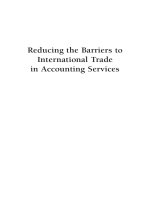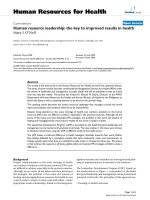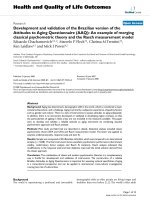The Microguide to Process Modeling in Bpmn 2.0 by MR Tom Debevoise and Rick Geneva_12 docx
Bạn đang xem bản rút gọn của tài liệu. Xem và tải ngay bản đầy đủ của tài liệu tại đây (1.95 MB, 27 trang )
The plot of the residuals versus the predictor variable temperature (row 1, column 2) and of the
residuals versus the predicted values (row 1, column 3) indicate a distinct pattern in the residuals.
This suggests that the assumption of random errors is badly violated.
Residual
Plot
We generate a full-sized residual plot in order to show more detail.
4.6.4.4. Quadratic/Quadratic Rational Function Model
(4 of 5) [5/1/2006 10:22:57 AM]
The full-sized residual plot clearly shows the distinct pattern in the residuals. When residuals
exhibit a clear pattern, the corresponding errors are probably not random.
4.6.4.4. Quadratic/Quadratic Rational Function Model
(5 of 5) [5/1/2006 10:22:57 AM]
4. Process Modeling
4.6. Case Studies in Process Modeling
4.6.4. Thermal Expansion of Copper Case Study
4.6.4.5.Cubic/Cubic Rational Function Model
C/C
Rational
Function
Model
Since the Q/Q model did not describe the data well, we next fit a cubic/cubic (C/C) rational
function model.
We used Dataplot to fit the C/C rational function model with the following 7 subset points to
generate the starting values.
TEMP THERMEXP
10 0
30 2
40 3
50 5
120 12
200 15
800 20
Exact
Rational
Fit Output
Dataplot generated the following output from the exact rational fit command. The output has been
edited for display.
EXACT RATIONAL FUNCTION FIT
NUMBER OF POINTS IN FIRST SET = 7
DEGREE OF NUMERATOR = 3
DEGREE OF DENOMINATOR = 3
NUMERATOR A0 A1 A2 A3 =
-0.2322993E+01 0.3528976E+00 -0.1382551E-01
0.1765684E-03
DENOMINATOR B0 B1 B2 B3 =
0.1000000E+01 -0.3394208E-01 0.1099545E-03
0.7905308E-05
APPLICATION OF EXACT-FIT COEFFICIENTS
TO SECOND PAIR OF VARIABLES
NUMBER OF POINTS IN SECOND SET = 236
NUMBER OF ESTIMATED COEFFICIENTS = 7
RESIDUAL DEGREES OF FREEDOM = 229
RESIDUAL SUM OF SQUARES = 0.78246452E+02
4.6.4.5. Cubic/Cubic Rational Function Model
(1 of 5) [5/1/2006 10:22:58 AM]
RESIDUAL STANDARD DEVIATION (DENOM=N-P) = 0.58454049E+00
AVERAGE ABSOLUTE RESIDUAL (DENOM=N) = 0.46998626E+00
LARGEST (IN MAGNITUDE) POSITIVE RESIDUAL = 0.95733070E+00
LARGEST (IN MAGNITUDE) NEGATIVE RESIDUAL = -0.13497944E+01
LARGEST (IN MAGNITUDE) ABSOLUTE RESIDUAL = 0.13497944E+01
The important information in this output are the estimates for A0, A1, A2, A3, B1, B2, and B3
(B0 is always set to 1). These values are used as the starting values for the fit in the next section.
Nonlinear
Fit Output
Dataplot generated the following output for the nonlinear fit. The output has been edited for
display.
LEAST SQUARES NON-LINEAR FIT
SAMPLE SIZE N = 236
MODEL THERMEXP =(A0+A1*TEMP+A2*TEMP**2+A3*TEMP**3)/
(1+B1*TEMP+B2*TEMP**2+B3*TEMP**3)
REPLICATION CASE
REPLICATION STANDARD DEVIATION = 0.8131711930D-01
REPLICATION DEGREES OF FREEDOM = 1
NUMBER OF DISTINCT SUBSETS = 235
FINAL PARAMETER ESTIMATES (APPROX. ST. DEV.) T
VALUE
1 A0 1.07913 (0.1710 )
6.3
2 A1 -0.122801 (0.1203E-01)
-10.
3 A2 0.408837E-02 (0.2252E-03)
18.
4 A3 -0.142848E-05 (0.2610E-06)
-5.5
5 B1 -0.576111E-02 (0.2468E-03)
-23.
6 B2 0.240629E-03 (0.1060E-04)
23.
7 B3 -0.123254E-06 (0.1217E-07)
-10.
RESIDUAL STANDARD DEVIATION = 0.0818038210
RESIDUAL DEGREES OF FREEDOM = 229
REPLICATION STANDARD DEVIATION = 0.0813171193
REPLICATION DEGREES OF FREEDOM = 1
LACK OF FIT F RATIO = 1.0121 = THE 32.1265% POINT OF
THE
F DISTRIBUTION WITH 228 AND 1 DEGREES OF FREEDOM
The above output yields the following estimated model.
4.6.4.5. Cubic/Cubic Rational Function Model
(2 of 5) [5/1/2006 10:22:58 AM]
Plot of
C/C
Rational
Function
Fit
We generate a plot of the fitted rational function model with the raw data.
The fitted function with the raw data appears to show a reasonable fit.
6-Plot for
Model
Validation
Although the plot of the fitted function with the raw data appears to show a reasonable fit, we
need to validate the model assumptions. The 6-plot is an effective tool for this purpose.
4.6.4.5. Cubic/Cubic Rational Function Model
(3 of 5) [5/1/2006 10:22:58 AM]
The 6-plot indicates no significant violation of the model assumptions. That is, the errors appear
to have constant location and scale (from the residual plot in row 1, column 2), seem to be
random (from the lag plot in row 2, column 1), and approximated well by a normal distribution
(from the histogram and normal probability plots in row 2, columns 2 and 3).
Residual
Plot
We generate a full-sized residual plot in order to show more detail.
4.6.4.5. Cubic/Cubic Rational Function Model
(4 of 5) [5/1/2006 10:22:58 AM]
The full-sized residual plot suggests that the assumptions of constant location and scale for the
errors are valid. No distinguishing pattern is evident in the residuals.
Conclusion We conclude that the cubic/cubic rational function model does in fact provide a satisfactory
model for this data set.
4.6.4.5. Cubic/Cubic Rational Function Model
(5 of 5) [5/1/2006 10:22:58 AM]
4. Process Modeling
4.6. Case Studies in Process Modeling
4.6.4. Thermal Expansion of Copper Case Study
4.6.4.6.Work This Example Yourself
View
Dataplot
Macro for
this Case
Study
This page allows you to repeat the analysis outlined in the case study
description on the previous page using Dataplot, if you have
downloaded and installed it. Output from each analysis step below will
be displayed in one or more of the Dataplot windows. The four main
windows are the Output window, the Graphics window, the Command
History window and the Data Sheet window. Across the top of the main
windows there are menus for executing Dataplot commands. Across the
bottom is a command entry window where commands can be typed in.
Data Analysis Steps Results and Conclusions
Click on the links below to start Dataplot and run this case
study yourself. Each step may use results from previous
steps, so please be patient. Wait until the software verifies
that the current step is complete before clicking on the next
step.
The links in this column will connect you with more detailed
information about each analysis step from the case study
description.
1. Get set up and started.
1. Read in the data.
1. You have read 2 columns of numbers
into Dataplot, variables thermexp
and temp.
2. Plot the data.
1. Plot thermexp versus temp. 1. Initial plot indicates that a
nonlinear model is required.
4.6.4.6. Work This Example Yourself
(1 of 2) [5/1/2006 10:22:58 AM]
4. Fit a Q/Q rational function model.
1. Perform the Q/Q fit and plot the
predicted values with the raw data.
2. Perform model validation by
generating a 6-plot.
3. Generate a full-sized plot of the
residuals to show greater detail.
1. The model parameters are estimated.
The plot of the predicted values with
the raw data seems to indicate a
reasonable fit.
2. The 6-plot shows that the
residuals follow a distinct
pattern and suggests that the
randomness assumption for the
errors is violated.
3. The full-sized residual plot shows
the non-random pattern more
clearly.
3. Fit a C/C rational function model.
1. Perform the C/C fit and plot the
predicted values with the raw data.
2. Perform model validation by
generating a 6-plot.
3. Generate a full-sized plot of the
residuals to show greater detail.
1. The model parameters are estimated.
The plot of the predicted values with
the raw data seems to indicate a
reasonable fit.
2. The 6-plot does not indicate any
notable violations of the
assumptions.
3. The full-sized residual plot shows
no notable assumption violations.
4.6.4.6. Work This Example Yourself
(2 of 2) [5/1/2006 10:22:58 AM]
4. Process Modeling
4.7.References For Chapter 4: Process
Modeling
Handbook of Mathematical Functions with Formulas, Graphs and Mathematical Tables
(1964) Abramowitz M. and Stegun I. (eds.), U.S. Government Printing Office,
Washington, DC, 1046 p.
Berkson J. (1950) "Are There Two Regressions?," Journal of the American Statistical
Association, Vol. 45, pp. 164-180.
Carroll, R.J. and Ruppert D. (1988) Transformation and Weighting in Regression,
Chapman and Hall, New York.
Cleveland, W.S. (1979) "Robust Locally Weighted Regression and Smoothing
Scatterplots," Journal of the American Statistical Association, Vol. 74, pp. 829-836.
Cleveland, W.S. and Devlin, S.J. (1988) "Locally Weighted Regression: An Approach to
Regression Analysis by Local Fitting," Journal of the American Statistical Association,
Vol. 83, pp. 596-610.
Fuller, W.A. (1987) Measurement Error Models, John Wiley and Sons, New York.
Graybill, F.A. (1976) Theory and Application of the Linear Model, Duxbury Press,
North Sciutate, Massachusetts.
Graybill, F.A. and Iyer, H.K. (1994) Regression Analysis: Concepts and Applications,
Duxbury Press, Belmont, California.
Harter, H.L. (1983) "Least Squares," Encyclopedia of Statistical Sciences, Kotz, S. and
Johnson, N.L., eds., John Wiley & Sons, New York, pp. 593-598.
Montgomery, D.C. (2001) Design and Analysis of Experiments, 5th ed., Wiley, New
York.
Neter, J., Wasserman, W., and Kutner, M. (1983) Applied Linear Regression Models,
Richard D. Irwin Inc., Homewood, IL.
Ryan, T.P. (1997) Modern Regression Methods, Wiley, New York
Seber, G.A.F and Wild, C.F. (1989) Nonlinear Regression, John Wiley and Sons, New
York.
4.7. References For Chapter 4: Process Modeling
(1 of 2) [5/1/2006 10:22:58 AM]
Stigler, S.M. (1978) "Mathematical Statistics in the Early States," The Annals of
Statistics, Vol. 6, pp. 239-265.
Stigler, S.M. (1986) The History of Statistics: The Measurement of Uncertainty Before
1900, The Belknap Press of Harvard University Press, Cambridge, Massachusetts.
4.7. References For Chapter 4: Process Modeling
(2 of 2) [5/1/2006 10:22:58 AM]
4. Process Modeling
4.8.Some Useful Functions for Process
Modeling
Overview of
Section 4.8
This section lists some functions commonly-used for process modeling.
Constructing an exhaustive list of useful functions is impossible, of
course, but the functions given here will often provide good starting
points when an empirical model must be developed to describe a
particular process.
Each function listed here is classified into a family of related functions,
if possible. Its statistical type, linear or nonlinear in the parameters, is
also given. Special features of each function, such as asymptotes, are
also listed along with the function's domain (the set of allowable input
values) and range (the set of possible output values). Plots of some of
the different shapes that each function can assume are also included.
Contents of
Section 4.8
Univariate Functions
Polynomials1.
Rational Functions2.
1.
4.8. Some Useful Functions for Process Modeling
[5/1/2006 10:22:59 AM]
4. Process Modeling
4.8. Some Useful Functions for Process Modeling
4.8.1.Univariate Functions
Overview of
Section 8.1
Univariate functions are listed in this section. They are useful for
modeling in their own right and they can serve as the basic building
blocks for functions of higher dimension. Section 4.4.2.1 offers some
advice on the development of empirical models for higher-dimension
processes from univariate functions.
Contents of
Section 8.1
Polynomials1.
Rational Functions2.
4.8.1. Univariate Functions
[5/1/2006 10:22:59 AM]
4. Process Modeling
4.8. Some Useful Functions for Process Modeling
4.8.1. Univariate Functions
4.8.1.1.Polynomial Functions
Polynomial
Functions
A polynomial function is one that has the form
with n denoting a non-negative integer that defines the degree of the
polynomial. A polynomial with a degree of 0 is simply a constant, with a
degree of 1 is a line, with a degree of 2 is a quadratic, with a degree of 3 is a
cubic, and so on.
Polynomial
Models:
Advantages
Historically, polynomial models are among the most frequently used
empirical models for fitting functions. These models are popular for the
following reasons.
Polynomial models have a simple form.1.
Polynomial models have well known and understood properties.2.
Polynomial models have moderate flexibility of shapes.3.
Polynomial models are a closed family. Changes of location and scale
in the raw data result in a polynomial model being mapped to a
polynomial model. That is, polynomial models are not dependent on
the underlying metric.
4.
Polynomial models are computationally easy to use.5.
4.8.1.1. Polynomial Functions
(1 of 2) [5/1/2006 10:22:59 AM]
Polynomial
Model:
Limitations
However, polynomial models also have the following limitations.
Polynomial models have poor interpolatory properties. High degree
polynomials are notorious for oscillations between exact-fit values.
1.
Polynomial models have poor extrapolatory properties. Polynomials
may provide good fits within the range of data, but they will
frequently deteriorate rapidly outside the range of the data.
2.
Polynomial models have poor asymptotic properties. By their nature,
polynomials have a finite response for finite
values and have an
infinite response if and only if the
value is infinite. Thus
polynomials may not model asympototic phenomena very well.
3.
Polynomial models have a shape/degree tradeoff. In order to model
data with a complicated structure, the degree of the model must be
high, indicating and the associated number of parameters to be
estimated will also be high. This can result in highly unstable models.
4.
Example
The load cell calibration case study contains an example of fitting a
quadratic polynomial model.
Specific
Polynomial
Functions
Straight Line1.
Quadratic Polynomial2.
Cubic Polynomial3.
4.8.1.1. Polynomial Functions
(2 of 2) [5/1/2006 10:22:59 AM]
4. Process Modeling
4.8. Some Useful Functions for Process Modeling
4.8.1. Univariate Functions
4.8.1.1. Polynomial Functions
4.8.1.1.1.Straight Line
Function:
Function
Family: Polynomial
4.8.1.1.1. Straight Line
(1 of 2) [5/1/2006 10:23:00 AM]
Statistical
Type: Linear
Domain:
Range:
Special
Features: None
Additional
Examples: None
4.8.1.1.1. Straight Line
(2 of 2) [5/1/2006 10:23:00 AM]
4. Process Modeling
4.8. Some Useful Functions for Process Modeling
4.8.1. Univariate Functions
4.8.1.1. Polynomial Functions
4.8.1.1.2.Quadratic Polynomial
Function:
Function
Family: Polynomial
4.8.1.1.2. Quadratic Polynomial
(1 of 5) [5/1/2006 10:23:01 AM]
Statistical
Type: Linear
Domain:
Range:
Special
Features: None
Additional
Examples:
4.8.1.1.2. Quadratic Polynomial
(2 of 5) [5/1/2006 10:23:01 AM]
4.8.1.1.2. Quadratic Polynomial
(3 of 5) [5/1/2006 10:23:01 AM]
4.8.1.1.2. Quadratic Polynomial
(4 of 5) [5/1/2006 10:23:01 AM]
4.8.1.1.2. Quadratic Polynomial
(5 of 5) [5/1/2006 10:23:01 AM]
4. Process Modeling
4.8. Some Useful Functions for Process Modeling
4.8.1. Univariate Functions
4.8.1.1. Polynomial Functions
4.8.1.1.3.Cubic Polynomial
Function:
Function
Family: Polynomial
4.8.1.1.3. Cubic Polynomial
(1 of 8) [5/1/2006 10:23:02 AM]
Statistical
Type: Linear
Domain:
Range:
Special
Features: None
Additional
Examples:
4.8.1.1.3. Cubic Polynomial
(2 of 8) [5/1/2006 10:23:02 AM]
4.8.1.1.3. Cubic Polynomial
(3 of 8) [5/1/2006 10:23:02 AM]









